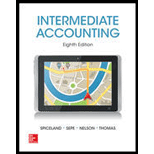
(1)
Stock options: Stock options are the stock-based compensation plans provided in the form of an option to buy certain number of shares for a certain price during certain period.
To mention: The stock options measurement date.
(1)
Explanation of Solution
The compensation cost of stock options would be measured on the grant date, January 1, 2016.
(2)
The amount of compensation expense of stock options
(2)
Explanation of Solution
Determine the amount of compensation expense to be recorded by Corporation E in 2016.
Step 1: Compute the total compensation cost of stock options.
Step 2: Compute the compensation expense of stock options allocated to each of the three vesting periods.
Note: Refer to Equation (1) for value and computation of total compensation cost.
Thus, compensation expense to be recorded in 2016 is $40,000,000.
(3)
The effect of forfeiture of 10% of stock options in 2017 and 2018
(3)
Explanation of Solution
Effect of forfeiture of stock options in 2017:
| Date | Account Titles and Explanation | Post Ref. | Debit ($) | Credit ($) | |
| 2017 | |||||
| Compensation Expense | 32,000,000 | ||||
| Paid-In Capital – Stock Options | 32,000,000 | ||||
| (To record changes in compensation expense due to forfeiture) | |||||
Table (1)
Working Notes:
Compute the new estimated expense allocated in 2017, after the 10% forfeiture.
Note: Refer to Equation (1) for value and computation of total compensation cost, and Equation (2) for value of compensation expense in 2016.
Thus the forfeiture of 10% of stock options reduces the compensation expense of $40,000,000 to $32,000,000 in 2017.
Effect of forfeiture of stock options in 2018:
| Date | Account Titles and Explanation | Post Ref. | Debit ($) | Credit ($) | |
| 2018 | |||||
| Compensation Expense | 36,000,000 | ||||
| Paid-In Capital – Stock Options | 36,000,000 | ||||
| (To record changes in compensation expense due to forfeiture) | |||||
Table (2)
Working Notes:
Compute the new estimated expense allocated in 2018, after the 10% forfeiture.
Note: Refer to Equation (1) for value and computation of total compensation cost, Equations (2), and (3) for values of compensation expense in 2016 and 2017.
Thus the forfeiture of 10% of stock options reduces the compensation expense of $40,000,000 to $36,000,000 in 2018.
(4)
To explain: If the accounting method followed for forfeiture is in consistent with the usual method applied for changes in estimates
(4)
Explanation of Solution
No, the method is inconsistent.
Generally, the revised expense for changes in estimates which would be allocated to each year would be deducted by 10%, the original expense recorded in 2016 ($40,000,000) would be reduced from the revised total cost, 90% of total compensation cost
(5)
To journalize: The options exercised on July 22, 2020
(5)
Explanation of Solution
| Date | Account Titles and Explanation | Post Ref. | Debit ($) | Credit ($) | |
| 2020 | |||||
| July | 22 | Cash | 216,000,000 | ||
| Paid-in Capital – Stock Options | 108,000,000 | ||||
| Common Stock | 18,000,000 | ||||
| Paid-in Capital–Excess of Par | 306,000,000 | ||||
| (To record purchase option exercised by stock option holders) | |||||
Table (3)
- Cash is an asset account. Since cash is received, asset value increased, and an increase in asset is debited.
- Paid-in Capital–Stock Options is a
stockholders’ equity account. Since stock options are exercised and shares are issued, stock options value is decreased, and a decrease in equity is debited. - Common Stock is a stockholders’ equity account. Since stock options are exercised and shares are issued, common stock value increased, and an increase in equity is credited.
- Paid-in Capital–Excess of Par is a stockholders’ equity account. Since stock options are exercised and shares are issued, excess of par value increased, and an increase in equity is credited.
Working Notes:
Compute cash received by Corporation E.
Compute the paid-in capital of stock options amount.
Compute the common stock amount.
Compute the paid-in capital–excess of par amount.
Note: Refer to Equations (4), (5), and (6) for all the values.
Want to see more full solutions like this?
Chapter 19 Solutions
Intermediate Accounting w/ Annual Report; Connect Access Card

 AccountingAccountingISBN:9781337272094Author:WARREN, Carl S., Reeve, James M., Duchac, Jonathan E.Publisher:Cengage Learning,
AccountingAccountingISBN:9781337272094Author:WARREN, Carl S., Reeve, James M., Duchac, Jonathan E.Publisher:Cengage Learning, Accounting Information SystemsAccountingISBN:9781337619202Author:Hall, James A.Publisher:Cengage Learning,
Accounting Information SystemsAccountingISBN:9781337619202Author:Hall, James A.Publisher:Cengage Learning, Horngren's Cost Accounting: A Managerial Emphasis...AccountingISBN:9780134475585Author:Srikant M. Datar, Madhav V. RajanPublisher:PEARSON
Horngren's Cost Accounting: A Managerial Emphasis...AccountingISBN:9780134475585Author:Srikant M. Datar, Madhav V. RajanPublisher:PEARSON Intermediate AccountingAccountingISBN:9781259722660Author:J. David Spiceland, Mark W. Nelson, Wayne M ThomasPublisher:McGraw-Hill Education
Intermediate AccountingAccountingISBN:9781259722660Author:J. David Spiceland, Mark W. Nelson, Wayne M ThomasPublisher:McGraw-Hill Education Financial and Managerial AccountingAccountingISBN:9781259726705Author:John J Wild, Ken W. Shaw, Barbara Chiappetta Fundamental Accounting PrinciplesPublisher:McGraw-Hill Education
Financial and Managerial AccountingAccountingISBN:9781259726705Author:John J Wild, Ken W. Shaw, Barbara Chiappetta Fundamental Accounting PrinciplesPublisher:McGraw-Hill Education





